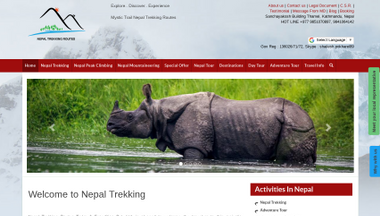I’m on the road today, so there will only be a handful of updates, but wanted to pass along this story. Over the past week or so, I’ve mentioned a couple of times that the spring Himalayan climbing season has pretty much wrapped up for the year, with all of the teams heading home. It turns out, that wasn’t completely correct, as a couple of climbers found themselves stranded on Makalu, and needed a rescue yesterday.
According to The Himalayan Times, Polish mountaineer Lech Wieslaw Flaczynski summited Makalu – the fight highest peak in the world – back on May 24, but ran into some difficulty on the descent. Climbing with his son, Wojciech Bartlomiej Flaczynski, both men topped out together last week, but when they turned back down the mountain, the elder Flaczynski lost his head lamp and then started to feel weak. To make matters worse, high winds struck the top of the mountain, making it very difficult for them to reach Camp 4. They ended up spending the night bivouacked high on the mountain.
The following day, the two Polish climbers were able to descend to Camp 4 and ended up staying there for three nights due to poor weather conditions. During that time, they started to run out of food and Lech developed altitude sickness.
When the weather cleared, the father and son team descended to Camp 3, but found no tents to take shelter in as all the other teams had already left the mountain. By this point, Lech was running out of bottled oxygen and was feeling very weak, so Wojciech moved back up the mountain towards C4 to look for a spare tank. He found one higher up the peak, which helped to keep his father alive. He says they ate chocolate, biscuits, and ice to stay alive.
A few days back, the duo were able to descend down to Camp 1 at 6600 meters (21,653 ft) where they were able to call for help. A rescue helicopter was scrambled to pick them up yesterday and they were flown to Kathmandu for treatment, where both father and son are said to be doing fine.
The bigger question here is why were they left on the mountain in the first place? The two men were climbing as part of team led by Spanish climber Jesus Morales Manzanares and supported by Seven Summits Treks. Somehow, that team abandoned them, didn’t alert anyone to their status, and just left Makalu. I’m not sure how or why that happened, but an investigation into the rest of that story should probably be in order. It’ll certainly be interesting to hear more about this story as the details come out.
Autor : Kraig Becker
* source: – Polish Climber Evacuated From Makalu After More Than a Week on the Mountain
** see also: – Trekking – posts on my site :
– Trekking in Nepal Himalaya : GOKYO, KALA PATTAR and EVEREST BASE CAMP TREK (19 days).
– Everest Base Camp – CLASSIC treks. / Version polish and english /
– Trekking in Nepal Himalaya : EVEREST HIGH VALLEY – Travel Guide. /Version english/
Filed under: Climbers, climbing, Expedition, Himalayas, Kraig Becker, mountaineering, Nepal, Polish Himalayas, Rescue climbing | Tagged: Himalaya, Makalu, mountaineering, Nepal, rescue | Leave a comment »


































